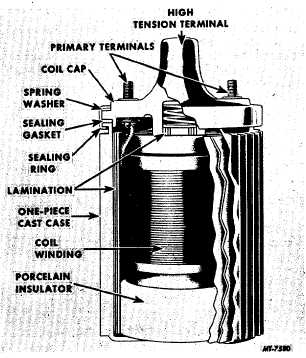|
| |
TRUCK SERVICE MANUAL
TM 5-4210-230-14&P-1
ELECTRICAL
DESCRIPTION
The ignition coil is a pulse transformer that steps up
the low battery or alternator voltage to the high voltage
necessary to jump the gaps at the spark plugs in the engine
cylinders. This voltage may reach as much as 20, 000 volts in
some installations.
The ignition coil, Figs. 1 and 2, contains three essential
parts: a primary winding consisting of a few hundred turns of
relatively heavy wire, a secondary winding consisting of many
thousand turns of very fine wire, and laminated soft iron which
serves to concentrate the magnetic field. The primary winding
is assembled around the outside of the secondary winding,
and the laminated iron is distributed so that one portion
serves as a core for the windings and the remainder as a shell
around the entire subassembly. This subassembly is then
placed in the coil case and the remaining. space nearly filled
with insulating compound :r oil and the coil cap assembled
into place.
Fig. 1 Steel Encased Coil (Cutaway View)
IGNITION COIL TYPES
There are a variety of ignition coils for various types of
operation, with each type of coil being supplied in several
models, each designed to incorporate a specified winding to
make it suitable for operation with a particular engine under
specific operating conditions.
Fig. 1 illustrates an oil-filled and hermetically sealed
ignition coil housed in a one piece steel case. Hermetic
sealing of the ignition coil prevents the entrance of moisture,
which would ultimately cause coil failure. Moisture may enter
an unsealed coil either directly in the form of rain, snow,
washing water, steam and so forth, or through the "breathing"
action of the coil itself. Unless a coil is hermetically sealed, it
will expel air when heated and will draw in outside air when
cooled. This is the action termed "breathing", and it results in
a gradual accumulation of water in the coil interior because of
the condensation of water vapor from the incoming air. In
addition to hermetic sealing, the coils are also filled with oil to
impart high dielectric strength to the insulation, thus further
reducing the possibility of insulation breakdown and coil
failure.
Fig. 2 illustrates a heavy-duty oil-filled and hermetically
sealed ignition coil housed in a one piece diecast aluminum
case. The fins cast in the case, plus the oil filling, permit
improved heat radiation, which is a factor in efficient ignition
coil performance.
Fig. 2 Diecast Encased Heavy-Duty Coil (Cutaway View)
CTS-2013-K Page 3
PRINTED IN UNITED STATES OF AMERICA
|


